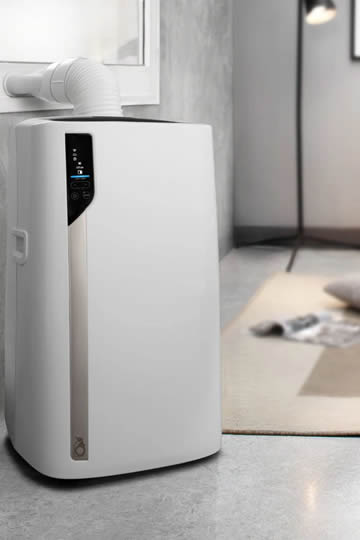Do Portable Air Conditioners Need to be Vented?
A surprisingly common question that gets asked is do portable air conditioners need to be vented using an ugly hose and why does it have to be through a window?
Fortunately, the answer is pretty simple and can be explained in terms that most people will understand.
To make things as clear as possible, it is first important to know, in simple terms, how an air conditioner works.
Refrigeration
 All air conditioners, regardless of design or layout, produce hot air as well as cold air.
All air conditioners, regardless of design or layout, produce hot air as well as cold air.
This is due to the refrigeration process, in much the same way a domestic fridge gives off a lot of heat at the back while keeping the stuff inside nice and cold.
If you've never noticed that before, just take a look at your own fridge and just feel how warm it gets at the back near the base where the motor (real name: condenser) is!
The same thing happens inside an air conditioning unit where the condenser is working hard and giving off a lot of heat. For a fuller explanation of how this happens, please read my article on why air conditioners are vented where I explain it in more detail.
Getting Rid of Heat from an AC
To make sure we only get cold air coming out of the AC and it is not mixed with hot air, the heated air is vented off and exhausted to the outside via ducting.
With fixed AC equipment such as central HVAC and mini-split AC, the ducting is generally put in place during installation to connect the internal cooling unit with the external unit (the one with the fan in) so that hot air can be dispersed outdoors.
Window AC units operate similarly, except the heat is expelled through the outward facing vents of the unit.
How Portable Air Conditioners Remove Hot Air
Portable air conditioners have a unique design to cope with the removal of the hot air that is created inside the unit.
A flexible exhaust hose connects to the back of the unit and the other end connects to a window vent to allow the hot air to escape to the outside.
Portable self-evaporating air conditioners work in the same way, as they also need to be able to remove excess moisture and hot air from the space.
The flexible hose can be insulated to improve efficiency and it can be easily be disconnected from the window in one room, the unit wheeled into another room and the hose connected to a window in that room. This gives the unit its portability.
Window Outlet, or Wall Outlet?
The easiest way for hot air to escape a room is through the window. It's easy to install a specially designed window fixing kit that comes with most models from the manufacturer.
Installing the window kit is often much simpler than drilling a hole in an external wall, which is another means of venting a portable AC unit if a suitable window is not available.
In some houses, there are already ventilation openings fitted with a fan in the walls of some rooms, particularly bedrooms. This type of vent can be used to attach the exhaust hose of a portable AC, making things even easier.
Other Venting Options Available for Portable AC Units
While using a window is generally the best option for venting a portable AC unit, there are other options available if no suitable window is available or if a hole cannot be made in an external brick wall.
Some rooms in older buildings have a chimney and this can be used to vent a portable AC as long as a long flue is installed inside the chimney. This is usually a job for professionals and may be outside the scope of the average handyman.
A practice to avoid is lazily placing the open end of the vent hose out through the door and running the unit. While it will cool the room it is in, the space outside the room will heat up pretty fast, making the rest of the house uncomfortably warm.
No Vent Option
If a portable AC cannot be adequately vented in a space, there is the option to instead buy a ventless air conditioner, which is really a swamp cooler (evaporative cooler).
This type of cooler does not use the refrigeration process to produce cold air, instead using the evaporation of water. No hot air is produced, so there is no need to vent this type of cooler.
Note: You need to live somewhere with low average humidity for an evaporative cooler to be effective.
Summary
To answer the question whether portable air conditioners need to be vented, whether it is out of a window, through a wall opening or by some other means, the short answer is YES!
All options should be explored and as long as a room has some exit point to the outside that can be exploited for ventilation, a portable AC can be run correctly vented.
It is not advised to run an unvented portable AC inside a room, as the result will be a net increase in temperature, which is not the desired result at all. Air conditioning should mean cooling to a comfortable temperature.
If you are unable to install the manufacturer's fixing kit to a suitable window, ask at the store where you bought it as often they will be able to recommend a professional installer that can help you.
Posted: May 6, 2022
[Back to Top]